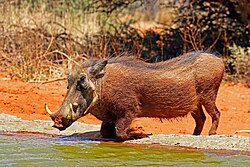| Warthog | |
|---|---|
 | |
| Male common warthog Phacochoerus africanus Tswalu Kalahari Reserve, South Africa | |
| Scientific classification | |
| Kingdom: | Animalia |
| Phylum: | Chordata |
| Class: | Mammalia |
| Order: | Artiodactyla |
| Family: | Suidae |
| Tribe: | Phacochoerini |
| Genus: | Phacochoerus F. Cuvier, 1826 |
| Type species | |
| Aper aethiopicus [1] Pallas, 1766 | |
| Species | |
| Synonyms | |
| |
Phacochoerus is a genus in the family Suidae, commonly known as warthogs (pronounced wart-hog). They are pigs who live in open and semi-open habitats, even in quite arid regions, in sub-Saharan Africa. The two species were formerly considered conspecific under the scientific name Phacochoerus aethiopicus, but today this is limited to the desert warthog, while the best-known and most widespread species, the common warthog (or simply warthog), is Phacochoerus africanus.




